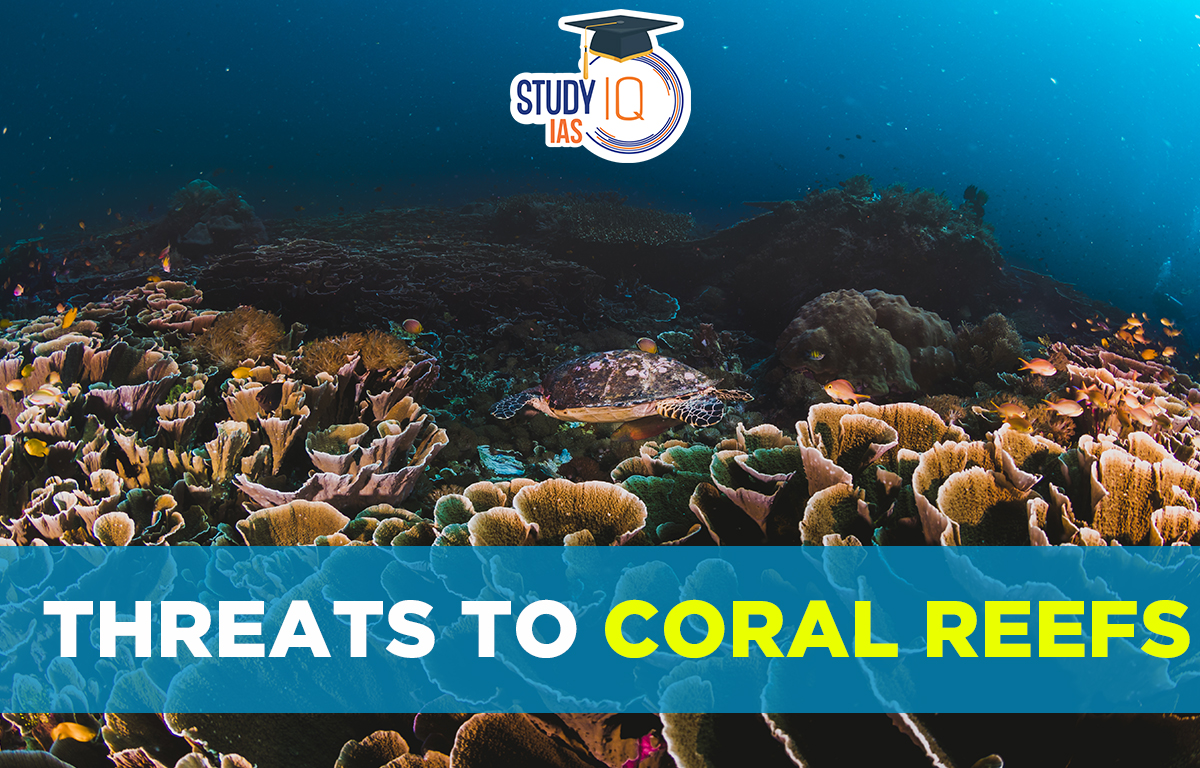Table of Contents
Context: International Coral Reef Initiative (ICRI) has pledged to raise $12 billion to protect coral reefs from threats like pollution and overfishing.
More on the News:
- The International Coral Reef Initiative (ICRI) will secure public and private investment to help conserve and restore coral ecosystems.
- ICRI is a global partnership between Nations and organizations which strives to preserve coral reefs and related ecosystems around the world.
- Launched in 1994, ICRI now includes 45 member countries, and aims to “secure the future” of 125,000 square kilometres of shallow-water tropical coral reefs and double the areas under effective protection by the end of the decade.
Climate Change and Threats to Coral Reef:
Global warming poses a significant threat to coral growth and reef accretion than ocean acidification.
- Ocean acidification (OA): OA is the gradual decrease in the pH of the Earth’s oceans due to the uptake of carbon dioxide (CO2) from the atmosphere.
- Reduced calcification: The lower pH of ocean water affects the growth and survival of coral reefs by reducing calcification rates in reef-building organisms i.e. coral polyps.
- Affects coral reproduction: Coral reefs reproduce by spawning eggs and sperm into the water. When the water is more acidic, the development and survival of coral larvae may be affected.
- Coral bleaching: When water is too warm, corals tend to expel the algae (zooxanthellae) living in their tissues causing the coral to turn completely white. This is called coral bleaching.
- As global warming continues, the frequency and severity of bleaching events will increase, making it harder for coral reefs to recover from these disturbances.
- Disease outbreaks: High temperatures can also increase the incidence and severity of coral diseases.
- Changes in storm patterns: Global Warming leads to stronger and more frequent storms that can cause the destruction of coral reefs.
- Sea level rise: may lead to increases in sedimentation for reefs located near land-based sources of sediment. Sedimentation runoff can lead to the smothering of coral.
- Reduced growth and reproduction: Increased water temperatures can also negatively affect the growth and reproduction of coral reefs.
- Changes in coral community composition: High temperatures can cause certain coral species to become more dominant or extinct, altering the composition of coral communities.
Case Study: 2016 & 2017 Mass coral bleaching in the Great Barrier Reef
- The Great Barrier Reef, located off the coast of Australia, is the largest coral reef system in the world.
- In 2016 and 2017, the Great Barrier Reef experienced mass bleaching events, which were caused by a combination of high ocean temperatures and El Niño.
- Both the events collectively affected almost two thirds of the Great Barrier Reef.

About coral reefs:
- Coral reefs are diverse underwater ecosystems formed primarily by the accumulation of calcium carbonate exoskeletons secreted by corals.
- They are often referred to as the “rainforests of the seas” due to their rich biodiversity and importance in supporting a wide range of marine life.
- Coral reefs provide habitats, breeding grounds, and food sources for countless species, making them crucial for the overall health of ocean ecosystems.

Types:
There are two main types of coral reefs:
- Fringing Reefs:
- Fringing reefs are located close to the shorelines of continents or islands.
- They develop directly from the coastline, and their shallow, nearshore environments make them easily accessible.
- Fringing reefs typically grow parallel to the shorelines, forming a border or fringe along the coastline.
- Barrier Reefs:
- Barrier reefs are found farther offshore, separated from the mainland by a lagoon or deep water.
- These reefs are characterized by a continuous and extensive reef structure parallel to the coastline, forming a barrier between the open ocean and the shoreline.
- Barrier reefs can be quite large, with the Great Barrier Reef in Australia being the most famous and largest example.
- Atoll:
- There is another type of coral reef called an “atoll,” which is a circular or oval-shaped reef that surrounds a central lagoon.
- Atolls are typically found in the open ocean, often formed on the remnants of submerged volcanic islands.
Stats IQ: Current scenario of degradation of coral reefs
- In 2019, the Global Coral Reef Monitoring Network (GCRMN) reported that coral reefs have declined by 50% in the last 30 years and it is expected that, this rate of decline could reach 70% by 2030.
Methods to protect and restore coral reefs:

Major Initiatives:
Several initiatives and programs that aim to protect and conserve coral reefs include:
- Global Coral Reef Monitoring Network (GCRMN): GCRMN is a network supported by the United Nations Environment Programme (UNEP) and other partners. It coordinates global monitoring efforts to assess the status and trends of coral reefs, facilitating data sharing and providing scientific information for conservation decision-making.
- Global Coral Reef Alliance (GCRA): GCRA is an international organization focused on coral reef restoration, research, and education. It works to develop and implement innovative techniques to restore damaged coral reefs and promotes sustainable management practices.
- The Global Coral Reef R&D Accelerator Platform: This platform aims to accelerate the development and implementation of cutting-edge science and technology solutions to address the threats facing coral reefs. It fosters collaboration between scientists, policymakers, and innovators to drive innovation and action for reef conservation.
- National Coastal Mission Program: In the case of India, the National Coastal Mission Program is an initiative aimed at protecting and sustaining coral reefs in the country. This program focuses on the conservation of coastal and marine ecosystems, including coral reefs, through various strategies such as research, awareness campaigns, and community engagement.
- Local and regional conservation efforts: Many countries and communities have implemented their own conservation initiatives, including the establishment of marine protected areas (MPAs) and the adoption of sustainable fishing practices.


 Niveshak Didi Initiative Phase 2 launche...
Niveshak Didi Initiative Phase 2 launche...
 Central Pollution Control Board (CPCB) R...
Central Pollution Control Board (CPCB) R...
 Foreign Contribution Regulation Act (FCR...
Foreign Contribution Regulation Act (FCR...





















